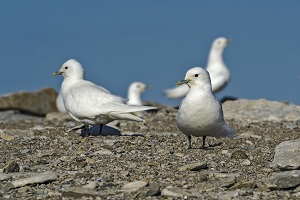Rosneft continues its research on the Ivory gulls

An expedition organized by Rosneft's Arctic Research Center and the Arctic and Antarctic Research Institute went to the northeastern Kara Sea to continue observations of the Ivory gull population, which began in 2020. Scientists will conduct research on this rare seabird species on Vise Island for the entire nesting period. It lasts for about two months. They're planning to collect data on food habits, the number of birds, and migration routes.
Environmental protection is one of the key priorities for Rosneft Oil Company in its operations. The Company implements a number of initiatives designed to preserve and restore natural resources, as well as to study arctic animals which are the most important bioindicators of the state of the environment. Since 2020, Rosneft has been implementing a targeted, innovative project called Assessment of Arctic ecosystem sustainability, based on research into the dynamics of key species.
The program of the expedition includes comprehensive work to determine the health of the population, as well as to obtain information about the peculiarities of the spatial location of the species. Scientists also plan to install camera traps and conduct visual inspections of the rookery. The data, which will be obtained this year, will make it possible to assess trophic relationships, to improve the methodology of systematic monitoring, as well as to fill the gap in scientific knowledge about the Ivory gull in the Russian part of the range. The results of this research will contribute to the conservation of this rare species.
Note for Editors:
Rosneft is implementing the corporate programme of research, conservation and monitoring of key species indicating the sustainability of the Arctic ecosystems, which are polar bear, Atlantic walrus, wild reindeer and Ivory gull, the rare gull subspecies listed in the Red Book of the Russian Federation. The Ivory gull, a rare and protected species, is the smallest and most endemic species of Arctic seabird with a limited breeding ground. Most of the global population nests in Russia from Spitsbergen eastward to the Laptev Sea. Included in the Red Book of the Russian Federation and the Red List of the International Union for Conservation of Nature.
The Ivory gull lives permanently in the Arctic. It is also referred to as a feathered polar bear, as it is so closely associated with the high latitudes. Even the population size of the Ivory gull is comparable to that of the main polar predator and they often live side by side.
The remoteness and inaccessibility of ivory gull's habitat and nesting areas and uneven distribution through the habitat area affect fragmentation of information on the number of the species and its dynamics, territorial links and population structure.
Ivory gulls are characterized by movements during the non-breeding period. The Ivory Gull is a typical seabird and only goes on land during the breeding season. Young and skip-breeding birds stay exclusively at sea and roam widely in the Arctic Ocean waters within the drifting ice zone.
Rosneft
Information Division
June 23, 2022